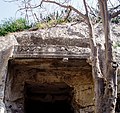Top Qs
Timeline
Chat
Perspective
Tuvixeddu necropolis
Archaeological site in Cagliari, Italy From Wikipedia, the free encyclopedia
Remove ads
The necropolis of Tuvixeddu (pronounced [tuviˈʒeɖːu] ⓘ) is a Punic necropolis, the largest in the Mediterranean.[1] It is located in a hill inside the city of Cagliari, Sardinia called Tuvixeddu (meaning "little cavity" in Sardinian).[1]
Remove ads
History
Between the 6th and 3rd centuries BC the Carthaginians chose this hill to bury their dead: these burials were reached through a well dug into the limestone rock (from two to eleven meters deep), a small opening introduced to the burial chamber. The burial chambers were beautifully decorated; there were found amphorae and ampoules for the essences. Of particular interest among the Punic tombs, the "Uraeus Tomb" and the "Fighter Tomb", decorated with paintings of palm trees and masks, still well preserved. Another famous tomb is that "of the Wheel".
On the slopes of the Tuvixeddu hill there is a Roman necropolis, which overlooked the road at the exit of the city. The Roman necropolis consists mainly of arcosolium tombs and columbaria.
The necropolis opened to the public in May 2014, during the XVIII edition of Monumenti Aperti. The archaeological area is large, it originally consisted of an area of about 80 hectares (200 acres).
Remove ads
Paleogenetics
A 2017 Ancient DNA study by Claudia Viganó et al. found that a man buried ~2000 years ago in the necropolis of Tuvixeddu carried the cod39 mutation that cause Beta thalassemia. The paternal and maternal haplogroups of this individual, suggests that he was likely autochthonous of Sardinia.[2]
Via Vittorio Veneto 40 cavity
This cavity is located a few metres from the artificial boundaries of Tuvixeddu, under the building that houses a high school. Until a few years ago, it was not visible because it was hidden by uninhabited and dilapidated blocks of flats, demolished for the final construction of the street. The Carthaginians used it as a water reservoir, as did the Romans later. During the bombardments it offered shelter to the city's population, and after the war it was inhabited by the homeless.
Gallery
- Aerial view of the site
- Reconstruction of a punic tomb of Tuvixeddu
- Decoration of the Ureaus tomb
- Roman tomb
- View of the hill of Tuvixeddu (center)
References
Sources
External links
Wikiwand - on
Seamless Wikipedia browsing. On steroids.
Remove ads








